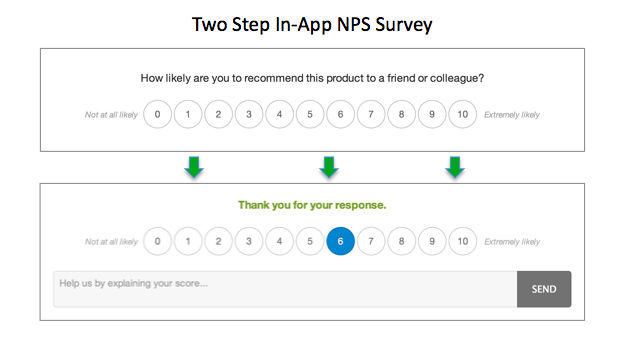You hear the term tossed around in most any meeting focused on customers: “What’s the NPS? How many Promoters do we have? How many Detractors?” You may be asking yourself “What is NPS and what should we be doing with it?”
Net Promoter Score (NPS) is a simple, powerful measure of customer loyalty. By asking customers to rate their likelihood to recommend a product or service on a 1-10 scale, you can gain actionable insights to guide decisions across your business.
Let’s break down NPS calculation and see how it works.
The NPS survey
Essentially, an NPS survey asks your customers this simple question:

The survey then logs the response and gives the responder a chance to explain their answer in an open-text format.

That’s it! Because the survey is short, sweet, and to the point, customers are more likely to respond. And you’ve just gained valuable information ready to be turned into insights and used to improve your offerings.
Many NPS surveys offer this text box at the bottom of the questionnaire asking for reasoning behind their responses. This is also a valuable tool to gain better insight into your customer’s specific experiences.
Collect NPS Data with a Survey
Make sure that during the process of NPS calculation you are determining what specific information you are looking for from your audience. Make sure you know what you need feedback on, where you have the bandwidth to improve, and how you want to segment your customers in order to get the most specific results.
InMoment can help you get instant NPS analytics when you download the NPS software. Want to try it out? Get a free 30-day trial here.
How to Calculate NPS: The NPS Calculation Process
Once you have the customer feedback (step one), the fun part begins with NPS calculation.
Respondents are classified into three groups based on their answers:
- Promoters: Rating 9 or 10. Loyal customers who are a great source of referrals.
- Passives: Rating 7 or 8. Customers who are satisfied with the service but are susceptible to competitors.
- Detractors: Rating 0 – 6. Unhappy customers who can damage your brand.

What is the NPS Formula, and How Does it Work NPS Calculations?
NPS Calculation gives you a clear indication from one moment to the next of how happy your customers are. Real-time tracking can alert you to threats to your business, allowing you to take quick action. Tracked over time, it gives you insight into which of the company’s actions have resulted in the most customer value. Step three is to find the percentage of promoters and detractors. Lastly, step four is to calculate the NPS score using the information you have acquired so far.
To do the actual NPS calculation, subtract the % of respondents who are Detractors from the % of respondents who are Promoters.
NPS = ((# of Promoters – # of Detractors)/Total Survey Participants) x 100
Interpreting Your NPS Score
Now that you’ve calculated your net promoter score, of course you want to know what the number you ended up with actually means. Net promoter scores are expressed as a number ranging from -100 to +100. Any score above 50 is typically a good NPS. This would be because at least 50% of your company is a promoter, while less than 50% would fall under detractor. The most important thing you can do with your net promoter score is acknowledge it, and try to improve it.
Utilizing Customer Feedback
The answer to the open-ended NPS follow-up question tells you the “why” behind the rating. Mining this text for insights is what makes NPS calculation so powerful – because it gives you rich information on the customer experience you’re providing. Analyze the text answers and use them to guide the actions you take.

Don’t forget to follow up with the customer and close the feedback loop. Imagine immediately responding to a Detractor’s complaint, targeting your Passives with an information campaign, or asking a Promoter to review your product online.
Creating Additional Questions for Your NPS Survey
When you create an NPS survey, you typically do so with the sole purpose of measuring NPS. However, sometimes you need to measure NPS and acquire additional information that can help you to improve after you’ve learned your NPS score. This is where you need some key driver analysis. While it’s usually used for Customer Acquisition, key driver analysis can help you identify what your strengths and weaknesses are specifically and how you should address them in the future.
Ongoing Voice of the Customer
Repeat the NPS survey at regular intervals. Segment your NPS by types of customers to understand the “why” behind your score and how your decisions impact customer loyalty.
Once you have NPS calculation down, you’ll be ready to add in additional metrics over time at key customer journey touchpoints. When you combine the feedback from your NPS survey with feedback from CSAT (customer satisfaction) and CES (customer effort) surveys, these 3 core CX metrics give you a great foundation for making business decisions based on the authentic voice of the customer feedback.
Build end-user loyalty. Sign up today for free in-app NPS calculation feedback with InMoment.



